The Spitfire Spares Mk VIII Spitfire
Welcome to the Spitfire Spares Full
scale replica page
Available
Very Soon
Climb
into
the
Cockpit
and Taxi
a MK
VIII
SPITFIRE
This is the story of the Spitfire Spares Spitfire.
UPDATED 21/08/07
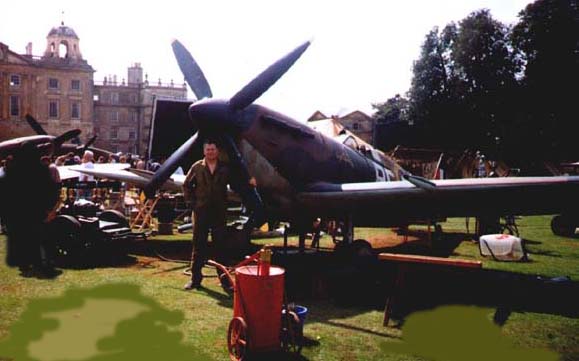
Finally we have
fitted to engine 04/02/07
Progress ought to be a bit more rapid
now, famous last word's.
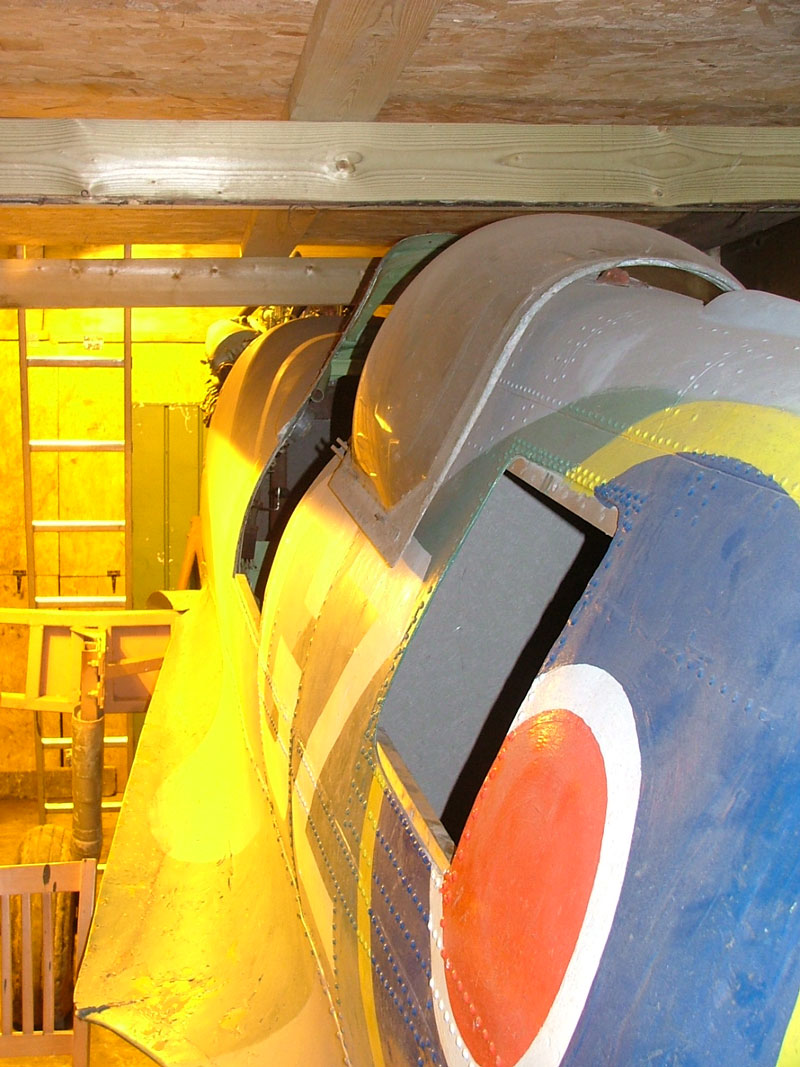
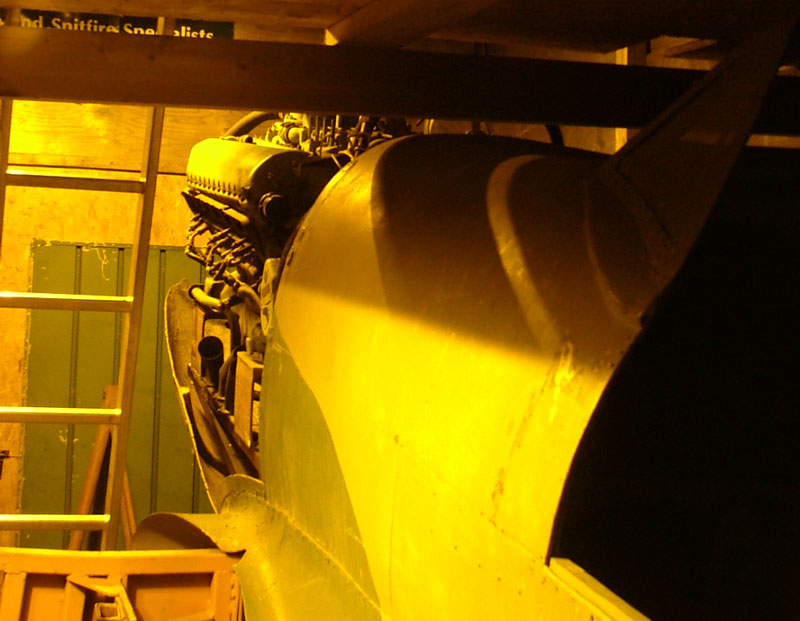


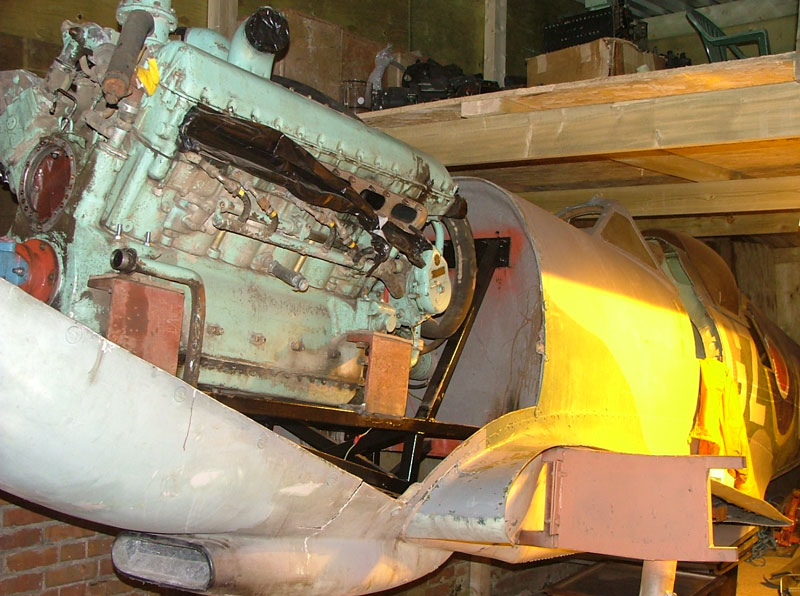
More Picture's added 5th march
2007 Fitting the exhaust stub's.
We have sorted the oil tank you can see it in the
pictures behind the fire wall in front of the instrument panel. We also have a
fuel tank, I bought it a couple of years ago with this job in mind and it fits
like a glove. I am mounting it behind the firewall above the oil tank. It has
two fuel outlets, perfect, and is also the right depth. The best thing of all it
has a fuel sender and itís a 38 gallon tank, it's Perfect, not a clue what's
it's from but it's dated 1947. I actually have a 38 gallon smithís fuel gauge. I
havenít got the correct 37 gallon, thought 38 was near enough. Looks allot
better now we have got rid of the air intakes and cooling outlet. We are going
to get good quality hose to connect the water, oil system and fuel. The great
thing about the hydraulic prop drive is that you can turn it off. The prop will
operate from the throttle as in the real deal and can be stopped completely.
This way we can run it at shows without all the worries of chopping someone's
head off. Shouldnít cost anymore to insure than a vintage car. Hoping to show
her off at Popham this summer. Lots to do yet
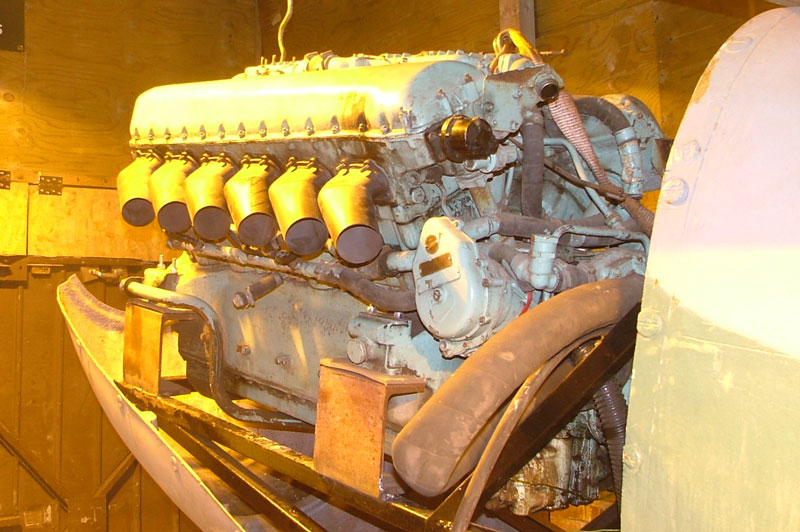
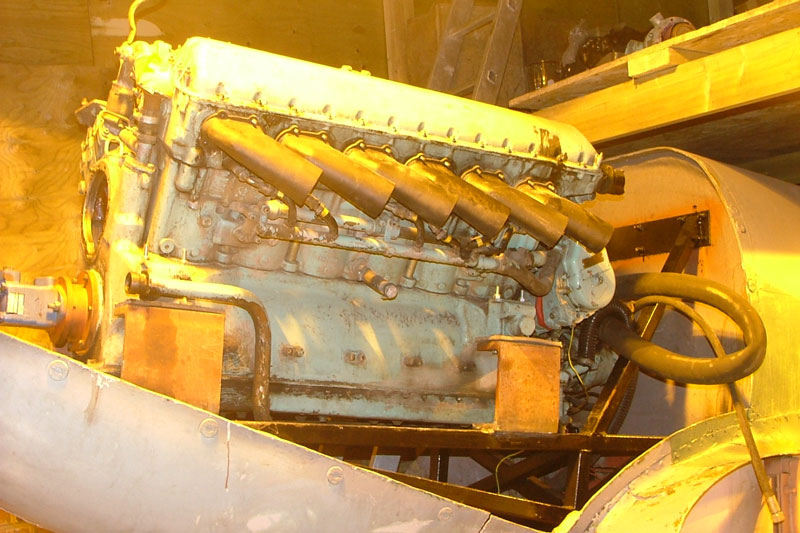
The Fuel tank
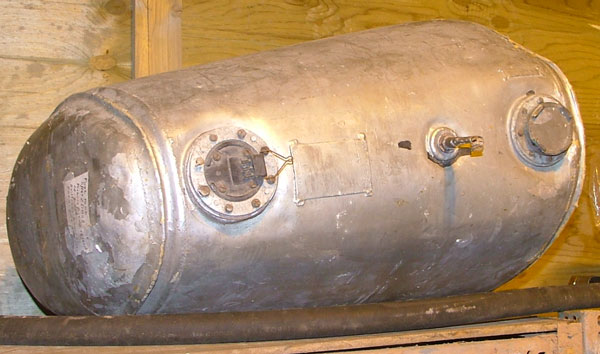
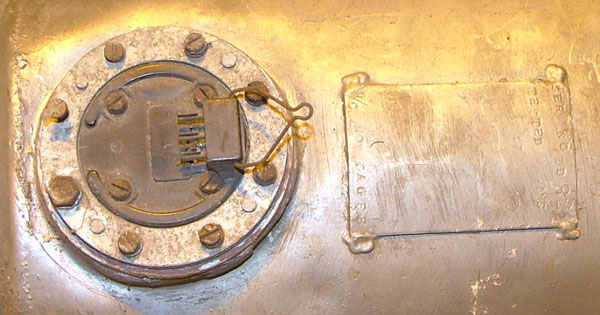

Updated 10 MARCH 2007
Having discovered the Stubs were
fabricated facing down instead of up they have been put right and the
cowling offered up for fitting.
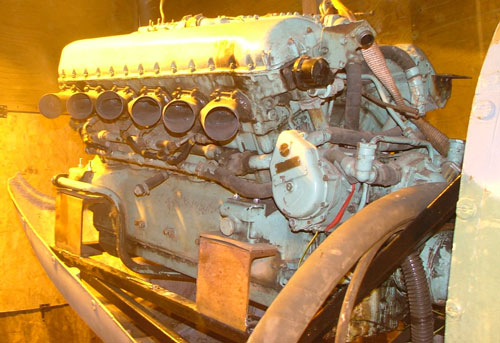
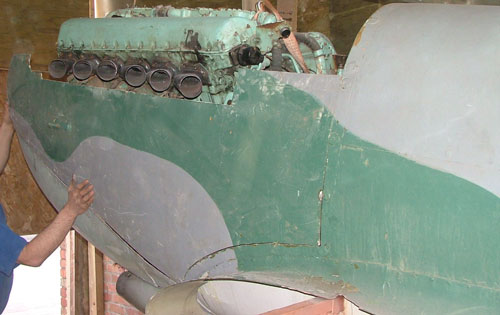
UPDATED 27/05/07
The engine to tank connections have been
completed. The flow of coolant is reversed through the carb manifold and the
rear head outlets and carb manifold flow directly back to the tank.
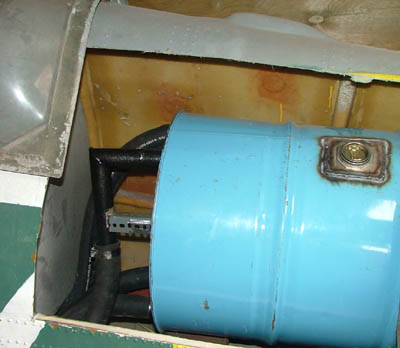
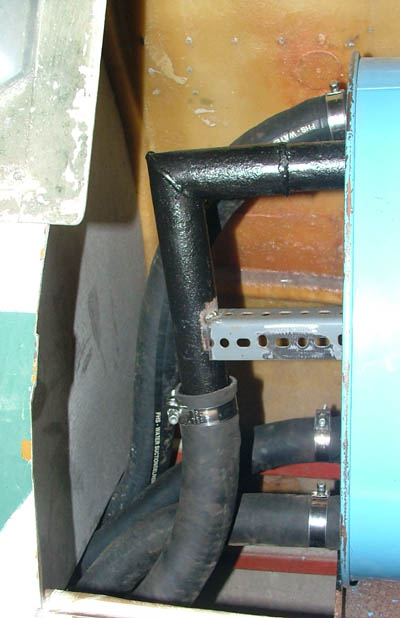

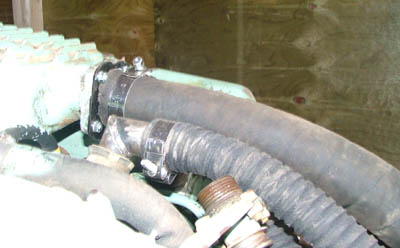
UPDATED 2106/07
Fuel tank rough first fitting
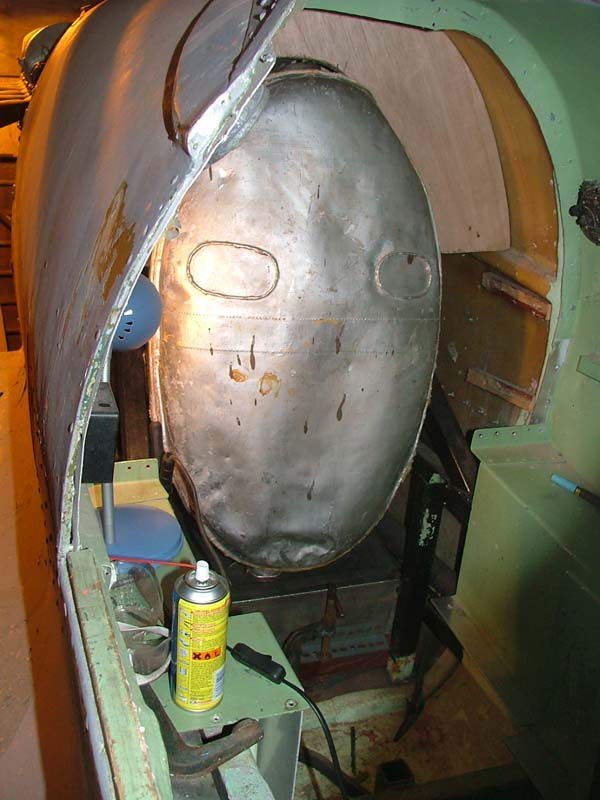
Note the oil tank below the fuel tank. There will
be heat proof matting on theoil tank and several layers of high impact foam.
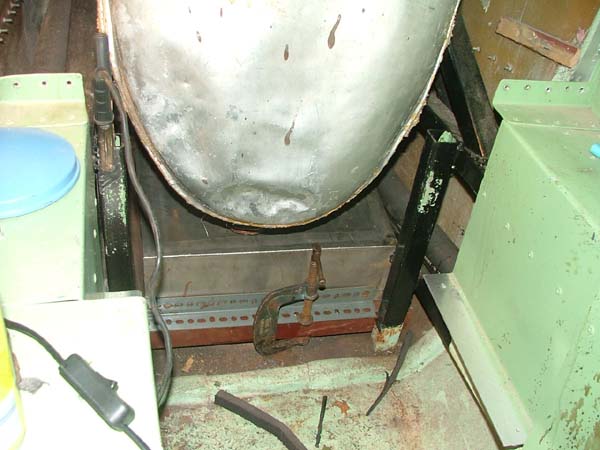
Water tank sealed in. The fuselage will receive a
complete make over when the mechanics are done so don't worry about the rough
fit.

Fuel tank final fit a bar with padding will be
welded in behind the fuel tank to seal it in place.
Note some of the instruments have been threaded
through from the engine ready for panel fitting.
The cockpit will be completely re- done, its a
bit rough at the present. Note the high impact rubber under the fuel tank, there
is a layer of heat proof material over the oil tank although we don't expect any
heat problems with the oil due to the limited running time.
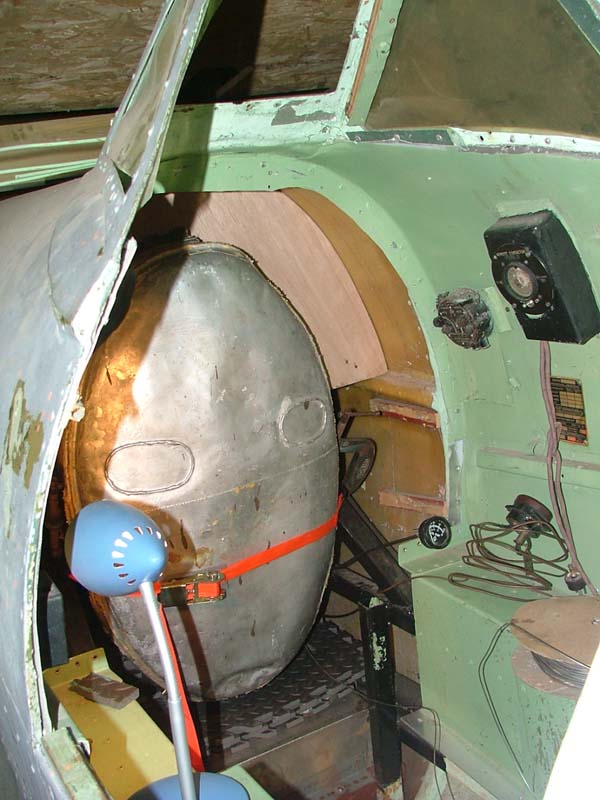

The engine with all oil and water connections in
place. The engine will be cleaned and repainted in black with some original
Merlin rockers
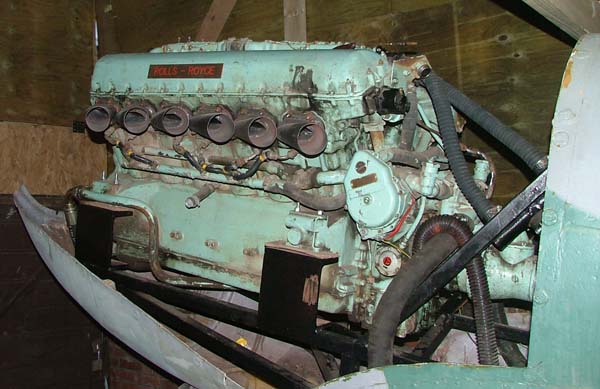
You can see the start of the throttle linkage at
the top of the engine mount. Its the tube on the triangular brackets.
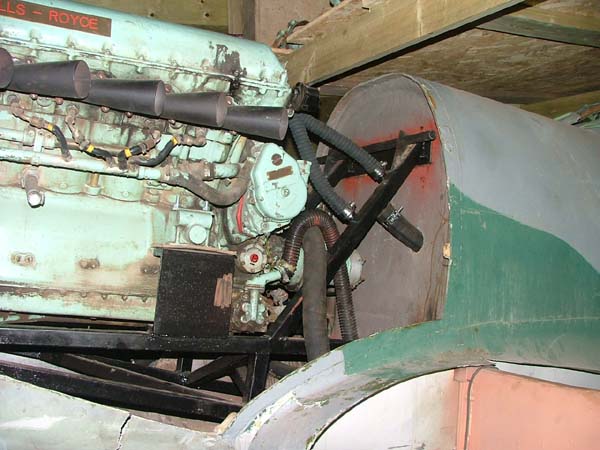
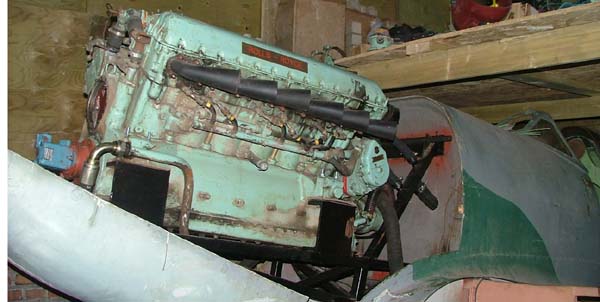
Note the oil pressure gauge sender unit in place
below.
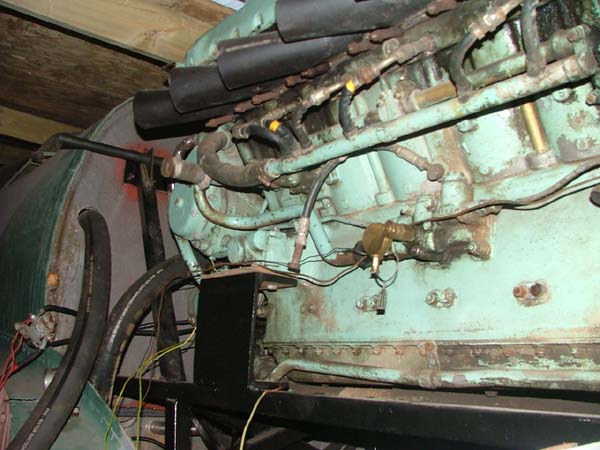
UPDATED 30/06/07
Fuel tank final fix, throttle in place, we had to
use a P47 Thunderbolt throttle as we don not have a genuine spitfire one at this
time. The rudder bars are in place to carry the pedals. Note the top and
underside of the fuel tank is lined with high impact foam. High impact foam to
lesson the vibration to the instrument panel fixed around the bulkhead.

Fuel tank, Oil tank, Throttle and rudder bars all
in place.
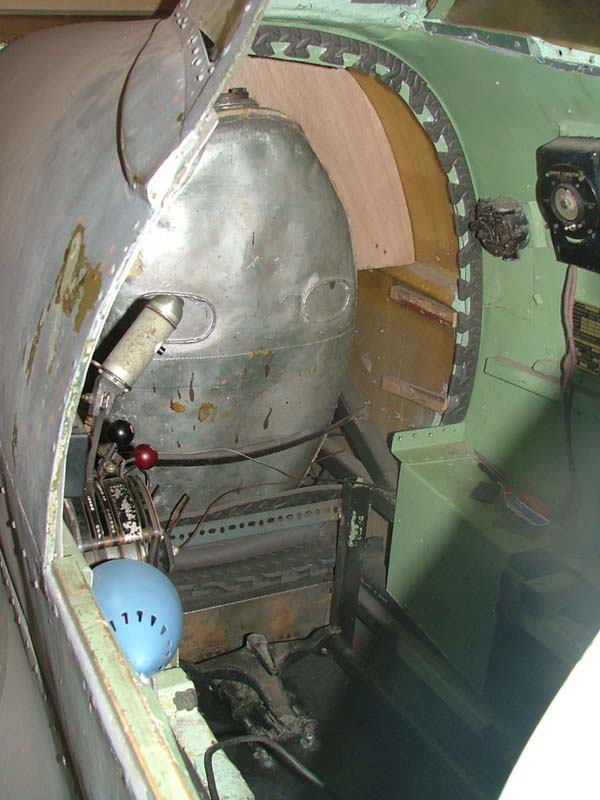
Throttle in place.

Rudder Bars, you can see the fuel lines running
out from the bottom left and right of the fuel tank.

UPDATED 05/07/07
Throttle linkage complete and
working. It may not look pretty but it works.
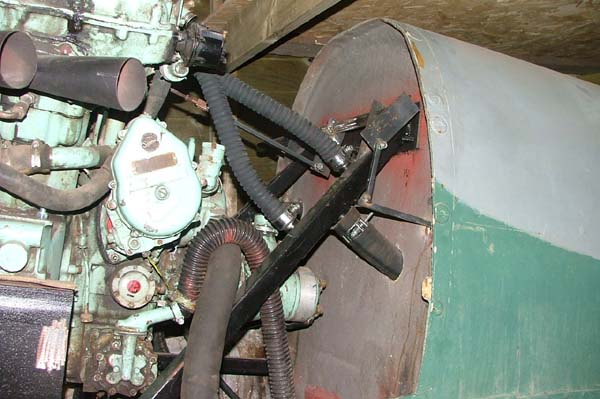
Here is the radiator neck finally fitted to the
carb cooling manifold, this will be connected to a header/overflow pipe
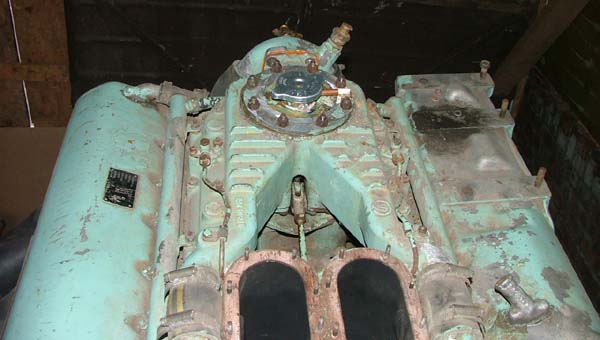
Original stick being fitted


UPDATED 10/07/07
Rudder bar and pedals in place

Rear of the rudder bars. The two holes in the
cross member will have threaded bar attached with solid bar running to the rear
wheel and rudder.
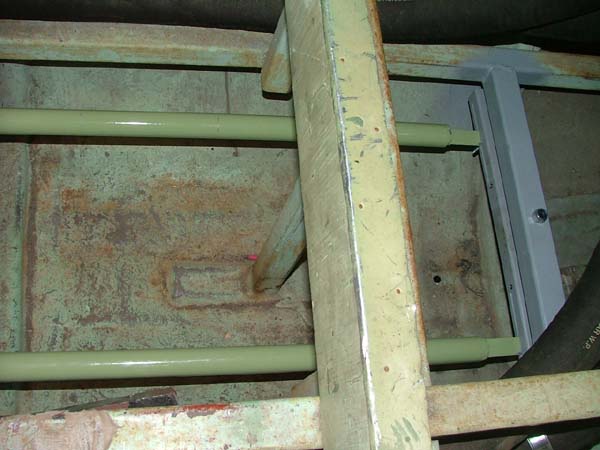
UPDATED 26/07/07
One part of My MKVIII Replica I want to keep as
original as possible is the cockpit. The rev counter was a challenge. The meteor
has an electric generator to drive the rev counter, the original Spit was of
coarse mechanical. The original rev drive ran off the cams at a 4:1 reduction,
i.e. 1/4 engine speed. So I needed a 4:1 reduction gearbox that would fit the
meteor drive for the Rev electrical generator. Tall order!!!! I have a few
generators that work the opposite way they convert mechanical drive from the
Merlin into electrical drive, out of curiosity I took one apart, what a result
they contain a 4:1 reduction gear box. Having removed the armature, I connected
the mechanical drive to the rev counter and gear box and put an electric drill
on the gear box. One problem the meteor rotates in the opposite direction
to the Merlin, that's when luck was really on side for a change, the rev counter
works quite happily regardless of which way the gear box spins. I guess they
designed them that way for different handed engines, I know this kind of rev
counter was used in loads of other RAF types with different engines. Here
is the unit connected up with the flexi drive cable attached.
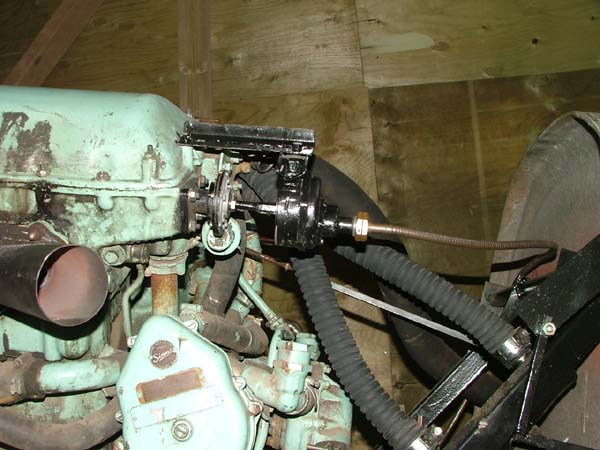
UPDATED 21/07/07
Tail wheel completed and fitted to rudder bars,
it works!!! The rudder has had lots of
fabrication to fit so that it works. The rudder,
tail plane and elevators will be removable
for transport. Some of the panels have been
prepped for painting.



Instrument panel being wired the fuel gauge now
works with the fuel tank sender
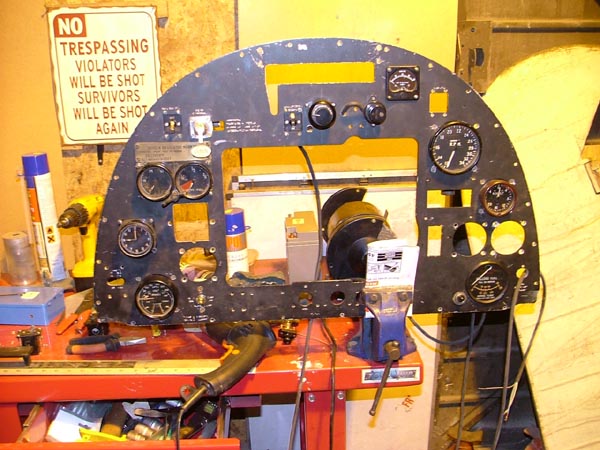
Manual Rev counter drive conversion in place, top
cowling has been test fitted.
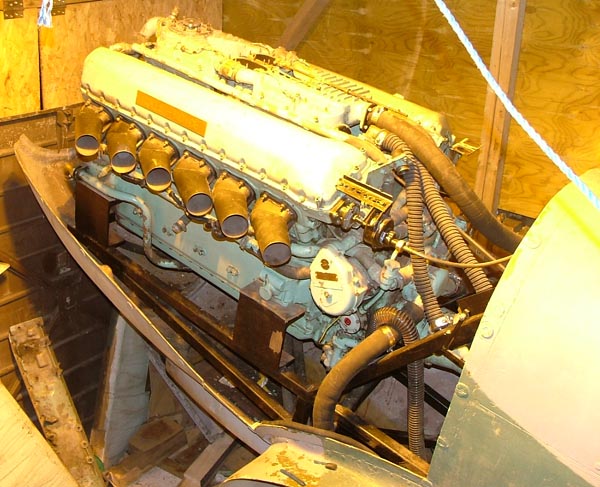
New Rudder pedals fabricated from steel the repro
alloy ones snapped and were like a
honeycombed inside.
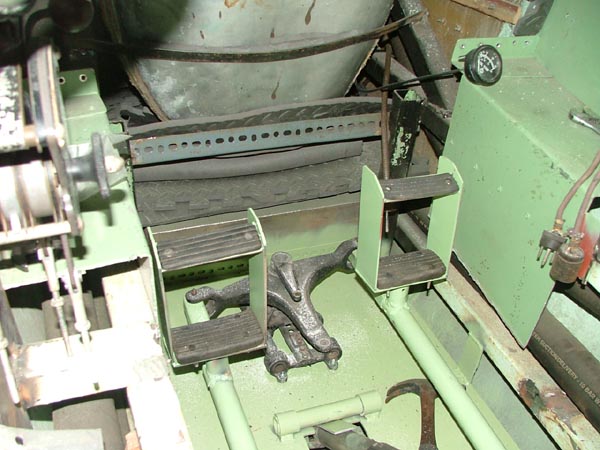
Technical info
Graham
I have only just read this (request on BTPA page) and note the reply from
Chris (our very good friend from tractor pulling) We run the jet tractor
Satans Toy, the Meteor tractor Devils Symphony, and the Alvis Leonides,
Lucifers Child (Riot Racing, Neal
And Nigel Davis) The modded distributor you saw on Salvage squad was all my
own work, but in reality was a complete load of rubbish, yes it did work,
but the sensor head was extremely fragile, so we have progressed a mile
since then. Nick Meade who is a friend and owns the tank has worked with us
now for 3 years and we have developed the perfect electronic conversion of
Meteor mags for the tanks. The mag is converted to run on 24 volts and
externally looks identical to the original, apart from a small discreet
lever to adjust the static timing. Power is a single wire that replaces the
wire which was originally the booster coil. We have found that if you
replace the inlet mag only, the engine will start virtually instantaneously
and the exhaust mag will pick up as soon as a couple of hundred RPM is
achieved. This is extremely important as the starter motors are also rubbish
and if the engine pops back the gears will almost certainly fail. Three of
Nicks Centurions are now fitted and it is notable that he is the only person
who has the confidence to take Centurions to shows at the moment, By the way
the Meteor in the tank is governed to 2500 rpm but if your 4b has a Merlin
Crank (this is highly likely if it is a late engine) it will run well above
3500. Devils Symphony is governed out at 4000 and this is very easy to
achieve with the electric ignition, by using an Omex adjustable rev limiter
(Demon Tweeks around ?80). At Heddington show Peter Grieve had his two
Merlins which are standard and set at 3000 RPM. Peter was well impressed
with our Meteor and you couldn't tell the difference when the two were
running, they sound identical. Our Meteor uses the same electronics as the
tanks but we mount the units into V12 jag distributor bases and run them on
the end of the cams, this is purely to save weight in the Mini tractor
class, as we run ordinary N9Y sparking plugs and ordinary plug leads. Timing
is critical on these engines for performance and to stop oil smoke, so this
also helps as we do away with the automatic advance retard.
QUESTION
I ended up getting new mags from some German tractor pullers,
they also fitted new plug caps so I can run with modern plugs. I have trying
without success until now to find out what plugs to use, they only burn
alcohol and didn't know.
I fitted the mags and now have a nice bright spark when the boost is
connected. I know what you mean about the starter, I removed the hand crank
when it jammed and it seems ok now. I like the idea of replacing one mag if
it starts better , but is it expensive?, on a tight budget.
I really need some advise because I know very little about the engine, have
read a few Merlin manuals but they are not the same. Cant seem to get a
meteor manual anywhere.
The plugs are a bloody nightmare to get out of the middle banks.
I am fitting it to my Full scale replica Spitfire so it can taxi and ground
run. I have made an engine mount, have fitted a hydraulic pump to the engine
which will drive the prop through an 1196 Ft/Llbs torque hub at 864 RPM. I
have made a stainless oil tank and have bought a 96GPH Holley self
regulating fuel pump as I intend to fit the fuel tank back in the tail away
from the engine and hot bits.
Fitting a complete original instrument panel and cockpit, all the
instruments and controls wire straight into the meteor, everything's ready
to fit as soon as I get the engine in.
ANSWER
Spark plugs that
we use are N12Y Champion number or any equivalent but if you get the small
body type with the little nut size (Ford use them a lot) they are a lot
easier to remove. The compression on a Meteor is only 6 to 1 so these plugs
are better than the original and the 12 number means they have a long snout
so they don't oil foul. We run conventional copper wire leads and ngk rubber
plug caps and have no trouble at all running on 100 LL Avgas. We run 3
Carter AFB 4 barrel race carbs and use the original fuel pumps with no
problem up to 4000 rpm. They are very good and are completely standard with
all other fighting vehicles so you can get them anywhere for next to
nothing. The Holley pump will need a fuel pressure regulator and return to
tank otherwise the original carbs will flood and fill up the centre of the
V, this is good for a fire. The original carbs are very restrictive and the
mags have a spark dump device that stops the engine at 2500 rpm. The starter
motor is going to be a bit of a pain as it will inevitably be at the back
and difficult to change, they are notoriously fragile and it is the
intermediate 6 tooth gear that is the problem. The hand turner is rarely a
problem and is very useful for timing the engine or generally fiddling about
so it might be useful to repair that. We have developed a modification to
the starter to double up the intermediate gear which seems to be working on
ours. I am working on getting a manual which if successful I will let you
copy. The oil system on the Meteor is a bit weird because in the tank it had
a 60 gallon tank and the oil cooler and filter were both in the scavenge
pump circuit and mounted above the scavenge pump. We of course only use
about 3 gallons of oil and this was not enough to prime the scavenge pump so
the sump just kept filling up, Which was Smokey to say the least. We have
modded ours to wet sump and removed the scavenge pump and she runs fine now,
but subsequently found that the scavenge pump needs a certain amount of oil
above it on the outlet side to keep it full. On the tank this is achieved
because the filter is mounted on the rocker cover. By the way the oil pickup
on the high pressure side is fairly critical in it's design so don't change
this, but we noticed that there is no filtration on the inlet side at all so
we have fitted an inline oil filter in the pickup pipe, (to protect the
pump) this is from a Renault tractor and is perfect, cheap, and dead easy to
fit. (I can get the part number if you want). and also we have fitted a full
flow high pressure spin on to the pump outlet. This is a standard Chevy Drag
race filter and handles the oil brilliantly, and of course can be changed
quickly as a service item, just like a car. The bottom end of a Meteor will
last forever so long as the oil is kept clean. The original filter was
massive, mounted on the rocker cover and only filtered the oil AFTER it had
been through the engine so was pretty useless, typical army design really.
The rocker covers are interchangeable with a tiny mod so we just got a
second plain cover and instantly have the Merlin look. We have some spares
by the way because our Meteor was complete and standard when we got it.
Peter has come up with a good mod to protect the rocker gear on his Merlins
which consists of an extra pipe being added to the heads through the
blanking plug holes and a little electric oil pump that will pressurise the
oil system to the rockers before start up. They are prone to stripping the
chrome faces during start as they dry out while standing, We have had one do
this but Peter supplied a spare and believe it or not it is only about a 15
minute job to change a rocker (well if you discount the half hour to get the
cover off). Your project sounds really great and if you need any advice or
help we will be only to pleased to try and help keep these machines
operating Oil tank capacity is no problem as the bottom end keeps very cool and
you
shouldn't need a cooler, (ours has no cooling whatsoever and only 3 gallons
of oil but after a full power run of around 30 seconds and also the drive
on, drive off, you can still put your hand on the sump which is barely warm,
rocker boxes are untouchable though) but the high pressure pump is the non
self priming type so you must keep your oil tank notionally above the oil
pump or have a saver tank that keeps a small amount of oil on top of the
pump so the pump is primed at start up. The same applies to the scavenge
pump which is why the oil pipe along the side of the sump rises up as it
goes into the sump on the sump pickup bulge. When the engine stops the oil
in the pipe cannot run up over the hump and remains in the pipe and keeps
the pump primed. Mags are no problem, we can definitely sort something there
for you and the cost can be sorted whenever. Our Meteor literally starts
first piston up, every time. Instrument wiring is easy (I'm trained in air
radar).
The Holley pump must have a pressure spec or adjuster, you will need to know
what pressure it regulates at, as the standard carbs can only handle about 5
psi or they will flood. Fuel consumption seems to be subject to a lot of
bragging and common sense can lead to the correct answers. I don't know how
much fuel a Spit carried but at 2 gallons a minute it would need 180 gallons
if you include the mandatory 50% safety factor for a 30 minute sortie, now I
may be ex RAF (Bomb Disposal) but even I believe that the Spit had a greater
range than that!. From our experience the Meteor uses about a gallon a
minute at 3500 RPM under full load and when idling at 750 RPM it is very
economical. In the tank at 30MPH it used two gallons per mile at 2500 RPM
which equates to 1 gallon per minute at full load. Realistically to save
continuous topping up a 10 gallon tank would be ideal which would give you
about a quarter of an hour of messing about. (this is all based on 100LL
Avgas as purchased from Peterborough Holmes airfield at ?1 .04 p per litre.)
It is true that you should stop a Merlin by switching off the fuel as it is
supercharged and as the engine runs down the blower will pump air and fuel
through to the exhaust pipes which are hot and bingo it all gets rather
spectacular. Not so for a normally aspirated engine as when you shut down
the carbs, next to no fuel can get in, so just switch off the sparks and
everything will be fine. As your engine will, like ours be running next to
no flywheel, if I understand your drive arrangements you will find it will
stop virtually instantly at switch off. In the tank you just have a normal
ignition switch arrangement just like a car.
QUESTION
My oil tank is about 8 gallons is this enough, I wasn't
planning to use an
oil cooler as I don't expect to run at full revs for more than 20 secs tops.
Just enough to get it taxiing. Is this going to work?
Also will the pump draw the oil up from the tank OK, I have the original oil
filter but have to move it somewhere below the rocker covers, I was going to
mount it on the engine mount above the starter motor.
I would greatly appreciate some help with the mags, I need it to start
reliably as im am hoping to offer taxi runs for enthusiasts if I ever get it
all working.
Would be great if you could visit im there most Saturdays working on the
Spit.
I have senders for instruments but not sure how to wire them, I have
original spit gauges with capillaries at present , but I should have the
electrical type on the MK8.
The holley pump I bought is supposed to be a self regulating type, its a
holley red electric 12 volt, its a smart bit of kit. Do I still need a
return and regulator?
How much petrol do they burn in standard form? I know a Merlin will burn up
to two gallons a minute , I was hoping for about 1/2 gallon a minute on tick
over. For safety sake I want to keep the fuel tank down to a minimum.
Is it true you have to switch the fuel off and let the engine run out of
fuel to turn it off, rather than earthing the mags? I have been told they
can catch on fire if you dont.
Graham
I would forget the existing oil filter, fit the Chevy spin on (this is about
5 inches in diameter and is about 10 inches tall, on our Meteor I have it
mounted on the left side just above where the mag would sit, directly above
the high pressure pump so that the outlet goes straight back into the
pressure control block on the side of the engine) and the inline filter
(this is very small) in the high pressure pickup between the tank and high
pressure pump.( go to
www.powerpulling.co.uk there are numerous pictures of
Devils Symphony and you can see the filter on the front, it is orange. The
oil and fuel tanks are the two round cylinders along the chassis sides, they
are made from irrigation tube!) How far away is your oil tank and at what
level is it compared with the high pressure pump. The scavenge return to
tank is no problem you just arrange the outlet pipe, to swan neck up a bit,
before dropping away to the tank, this ensures the pump doesn't dry out, the
standard pickup looks after the rest. To mod the Magneto we only require the
base in a sound mechanical condition. The electrical side is irrelevant but
we must have a good rotor arm. We do not need the distributor cover but we
do need the drive unit, and remember that the distributors/magneto's are
different in that they rotate in opposite directions so if you want to mod
the inlet magneto (recommended) we must have an inlet one to mod (they are
not interchangeable because of the centrifugal advance retard). Fuel:- In
fact the Meteor was tuned to run on 91 octane leaded fuel, standard for post
war military petrol, This is no longer available and the military now use 94
octane low lead (not unleaded) Your Meteor will run happily on 4 star (98
octane) leaded but it will run much better on 100 octane low lead or 100LL
avgas as it is in fact closer to 110 octane equivalent with the combustion
improvers that are added to keep piston engined aircraft running at
altitude. However strong our greenies are they can't change physics and a
piston engine needs combustion accelerators in rarified air! The Merlin was
designed to run on wartime avgas which was 130 L or 130 octane leaded. The
Battle of Britain flight spitfires run on 110 LL but do not have the
performance that the warbirds had. B of B do still have special 130 leaded
for the Messchersmidt which won't even run on 110!! By the way I have flown
in City of Lincoln, I'll tell you the story someday. The other reason for
using avgas is it is 30 p a litre cheaper. Our experience is that the fuel
pumps as fitted are completely adequate and will lift the fuel over quite a
distance, they have the added advantage that you can hand prime them and
they don't need an electrical feed. we think they are great and if yours are
no good I can get you a pair of new ones although our experience is that
they are generally very reliable. They have an advantage that they pump in
synchronisation with the engine RPM whereas an electric pump is constant or
too much at idle and not enough at high RPM. The Meteor is also fitted with
a special easy start system ( ha ha ) called KY gas priming. This is like
ether injection (you will see the little injector nozzles and pipes on the
inlet manifold) but you can if you wish adapt this and use it to prime the
engine with avgas which will start it and give the pumps a chance to catch
up. This can be manual or electrically pumped. The carburettors don't seem
to dry out unless the engine hasn't been run for a long time but our
experience is that they need a lot of fuel to start them. The Meteor is a
really good and fairly simple engine and suffers from only two real problems
i.e. poor sparks and a weak starter, overcome one or both of these and they
are extremely reliable.
QUESTION
I can keep the old filter above the oil pump, although it
sounds a poor
option.
Would like to use the oil filter you suggested. Perhaps I can remove the
filters and use the oil filter case as a tank to prime the pump? I have two
mags which are knackered, the steel pins which connect to the plugs leads
are badly corroded. I have two good mags on the engine could afford £150 OK.
Do I have to run on av gas? will my standard Mk4 b run on 4 star Leaded?
Perhaps I can do away with the holley, will the fuel pumps on the engine
lift fuel? or do they have to be pressure fed?
The oil tank should be no problem but as is the
case with the scavenge pump arrange the oil lift pipe to come up above the
pump and then drop back. This will ensure that the pump is always primed.
You will have to fit the lift filter (the Renault Tractor one) in somewhere
anyway so it will probably lend itself to go in the pipe and will add a
little reservoir to the lift pump. This filter is quite small and neat. Our
Meteor has the prop drive adapter removed and an 11.5 inch alloy flywheel
with a two plate Hayes clutch on it. The flywheel action of this is
negligible, but she will happily idle at about 750 RPM. Although the engine
will idle slower than this, the oil pressure to the cam gear gets very low
so we feel that 750 RPM is better for the engine. The hydraulics will help
as a flywheel so long as both the pump and motor are two way types. Great
that you have the K gass system but don't use the K gass, just put ordinary
avgas in it. K gass was basically ether and it is a great way of destroying
your starter motor. With the ignition upgrade all you need is a little
enrichment of the mixture on cold mornings. Nick's Centurions don't need the
primer or even choke unless the temperature is below about 10 C. You should
have no problem with the Avgas as long as you tell them that it is not going
to be used in a road car. In fact you can probably register your replica
with the flying club and buy the fuel against it. Most flying clubs make a
little profit from their fuel and are only to pleased to sell it. I take
either a 40 gallon drum or half a dozen gerry cans and there has never been
a problem. Get a receipt to keep in case you come up against the ministry
(tax guys). The plugs you have got are the identical ones to what we use and
they have never been a problem but they do need cleaning every now and
again, the Meteors and Merlins are notorious for oiling up but we have found
that you can improve this by running a modern quality oil (20/50 synthetic),
but then a real Spit had it's plugs changed every sortie! Don't throw the
Holley pump away, they are sought after by tractor pullers and dragracers
but I think the original pumps will be more than adequate and a lot less
trouble

|
